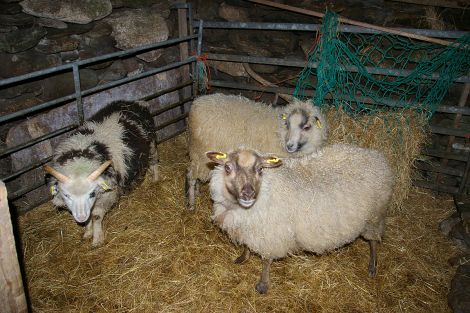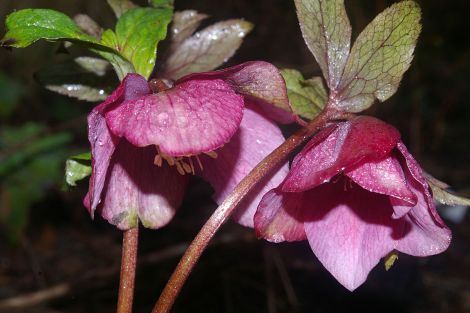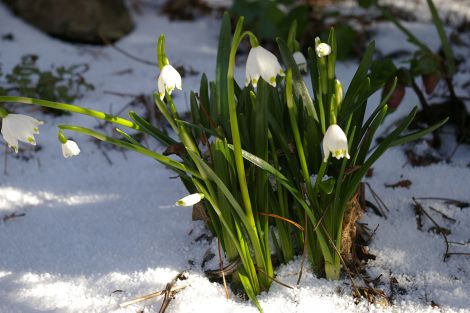Four Seasons / Four Seasons – Late Winter
It’s something we all need, can, or should get for free, but this winter there hasn’t exactly been much of it about.
1.4, 0.0, 0.5, 0.0, 0.0, 0.5, 2.0, are the values picked for a random week in February. A week that is pretty typical for each and every week this month – and the month before.
The figures are daily sunshine hours for Shetland West courtesy of www.weatheronline.co.uk, and I don’t expect the values for Shetland east, south or north to be markedly different. Nor sadly, in my experience, are they wholly untypical of certain Shetland summers I could mention.
Over 90 per cent of the Scottish population – and that includes us – are deficient in Vitamin D3 (cholecalciferol), during the winter months. Given our latitude, UV radiation is too weak to produce this vitamin for 6-7 months of the year.
Perhaps we can make up for this during the summer? Exposing arms and legs for half an hour during the times of year and day when our shadow is shorter than our body, is said to be sufficient to raise our vitamin D levels to an acceptable level – provided the sun happens to shine, which in my 30+ years experience of the Shetland weather, can rarely be guaranteed, and is borne out by the fact that ¾ of Scots are also deficient during the summer.
But what about those who spend a lot of time outdoors, gardeners for example? I still remember, with great fondness, the summer of 2008 when I managed to ripen tomatoes and Jerusalem artichokes outdoors and spent the best of three months (from June to August) in shorts and T-shirt. I was as brown as a berry, but found, much to my amazement, that my vitamin D blood levels were only just within the sufficient range.
Become a member of Shetland News
Some foods are rich in vitamin D, but in order to get enough from our diet, we’d have to eat oily fish three times a day, seven days a week. I’m inordinately fond of mackerel, herring and their oily cousins, but even I draw the line at 21 portions a week.
So how do we go about getting enough? Vitamin D3 can be taken as a supplement but is, at present, not licensed for prescription in the UK. There is good news however. According to one GP I consulted, D3 on prescription is just around the corner, and the perceived benefits by far outweigh any possible drawbacks, and the costs are minimal compared to other drugs.
Vitamin D is not only responsible for healthy muscles and bones (cases of rickets are on the rise in Scotland), but is also implicated in fighting infections, healing wounds, and reducing the winter blues. There is also growing evidence that optimal concentrations of vitamin D in our blood might reduce our risk of getting diabetes, heart disease, depression, and some cancers.
Voices stating that Scotland’s appalling health record and low life expectancy might not only relate to diet and life-style, but also to chronic vitamin D deficiency, are getting louder, and the NHS advises the taking of 400 IU (international units) per day for those at risk of deficiency. This is now thought to be too low: the American Institute of Medicine has declared up to 4000 IU daily as safe, and a growing consensus in the UK recommends 1000 to 2000 IU as an ideal daily dose for those in danger of deficiency.
The story doesn’t end here. Apart from a healthier population, there might well be some specific benefits for Shetland in connection with vitamin D, perhaps even in the form of some wise SIC investment, if that hasn’t become a contradiction in terms?
With more and more evidence regarding the beneficial effects of vitamin D3, there’s bound to be increasing demand, and we in Shetland are perfectly situated to meet some of this, as we already have an abundance of the raw material – sheep, or to be more precise, sheep’s wool.
We could manufacture vitamin D3 from lanolin. I’m envisaging a nice little export industry and a means of supplying the population of Shetland with cholecalciferol for free. If you want to learn more about vitamin D, go to www.vitamind3uk.com or www.vitamindcouncil.org
The sun did come out the other day, and even if it isn’t yet high enough in the sky to produce that vital vitamin, it certainly raises one’s spirits; and what a blessing that plants, unlike humans and other mammals, don’t depend on ideal UV radiation.
All they need is a rise in temperature or an increase in day length to come out of hibernation. With just one exception, all those late winter flowerers perform regardless. Drifts of snowdrops have been in full bloom for several weeks and are now joined by the spring snowflake, winter irises, witch hazels and glorious hellebores.
All flower their hearts out regardless of the sky being grey or blue, and the exception is the crocus. It will only open its flowers on a sunny day, so is best planted in a south-facing position. If, as has been the case this year, winter sunshine is a rare commodity, pick them. They have a decent vase life and waft their honey scent at room temperature.
There’s a little smattering of pale pink blossom on Prunus subhirtella ‘Autumnalis’, the autumn cherry. Rather than flowering in one fell swoop, as most cherries do, it produces little flurries throughout the winter with a substantial encore in March.
Alongside the plants, the gardener has also, at long last, come out of hibernation. Borders have been cleared of debris, primulas potted up, and tatties set out to sprout in egg cartons. The greenhouse, spick and span after a thorough spring clean, is chock-a-block with new sowings, the propagator is filled to capacity, and winter’s dankness and mould have given way to the incomparable smell of warming soil and growing seedlings.
Rosa Steppanova (www.leagardens.co.uk)
Become a member of Shetland News
Shetland News is asking its readers to consider paying for membership to get additional perks:
- Removal of third-party ads;
- Bookmark posts to read later;
- Exclusive curated weekly newsletter;
- Hide membership messages;
- Comments open for discussion.
If you appreciate what we do and feel strongly about impartial local journalism, then please become a member of Shetland News by either making a single payment, or setting up a monthly, quarterly or yearly subscription.











